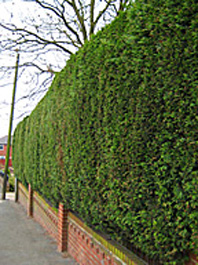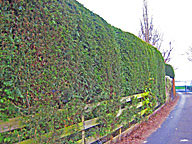Preparing to Plant a Hedge
Essential Planning
Hedges take considerable time to become established and should be considered as more or less permanent features of your garden, so a little careful planning beforehand can help avoid costly mistakes in terms of finance, time investment and effort.
Before embarking on any practical actions, it is worth considering the reasons for planting a hedge in the first place. A hedge forms a barrier in your garden. It is the green equivalent to a wall in your house and it can serve a number of purposes, for example:
- Dividing off different sections of your garden like a room divider in your house
- Hiding some less pleasing feature of the garden such as a shed, or screening a view that you prefer not to see from your garden
- Providing privacy perhaps from neighbours or casual passers by
- Acting as a sound barrier, for example to deaden the sound of passing traffic
- Providing security by preventing access to your property
- Protecting plants and other garden features from damaging weather conditions
- Offering a home and possibly a food-store for garden wildlife

Having decided the purpose (or purposes) of your hedge, you are in a better position to select the most appropriate plants to form the hedge, estimate how many plants you need and how much space they will occupy.
For example, if you want a hedge to screen out an ugly view, you will want it to be effective all year round. Many, though not all, deciduous plants would not be appropriate since they lose their leaves in winter.
On the other hand, if your only requirement is security or perhaps to control the movement of animals, you will want something that is as difficult as possible to penetrate but all year round foliage might be of little consequence.
Having thought about the purpose, you are ready to decide on the plants to use for your hedge. To some extent, this will depend on your soil and prevailing climate. For most of us, cost will also be important. Click over to some of our advertisers to give you ideas and act as a guide to selecting what is most appropriate.
However, since local conditions are also important, you would be wise to visit your local garden centres and nurseries, as well as walking your local area to see what is thriving in other people's gardens.
You need to decide on the plants you intend to use, but don't buy them just yet because there is plenty of preparation to do before you are ready to plant them.
Preparing the Ground for Planting

Having decided on the type of hedge, you need to prepare the ground.
Most hedges need to withstand some considerable forces of nature such as wind and snow. They might also be threatened by heavy rain or drought conditions. Consequently, just like a wall, they need good foundations.
In addition, because the plants need to be relatively close to each other, they are competing for water and nutrients throughout their lives. Consequently, ample supplies of both are essential.
The best preparation is to dig a trench where the hedge is to be planted. The size of the trench may vary according to many factors, but as a rough guide, it will need to be around two to three feet wide (60cm to 90cm) and about 18 inches deep (45cm).
If you have seen the plants you intend to buy at a local nursery, then you will know the depth required by the roots. Add on a few inches so there is room for a substantial layer of compost at the bottom of the trench.
When they are getting established, most hedging plants need plenty of water, so it is a good idea to fork over the bottom of the trench to loosen up the soil and then give it a really good soaking.
Plenty of food is the other essential ingredient. This can be in the form of a substantial layer of compost for the bottom of the trench along with some slow release fertiliser that you mix in with the soil from the trench.
When all the preparation is complete, you are ready to have your plants delivered.
Read more about Hedges |
Read more about Plants |
